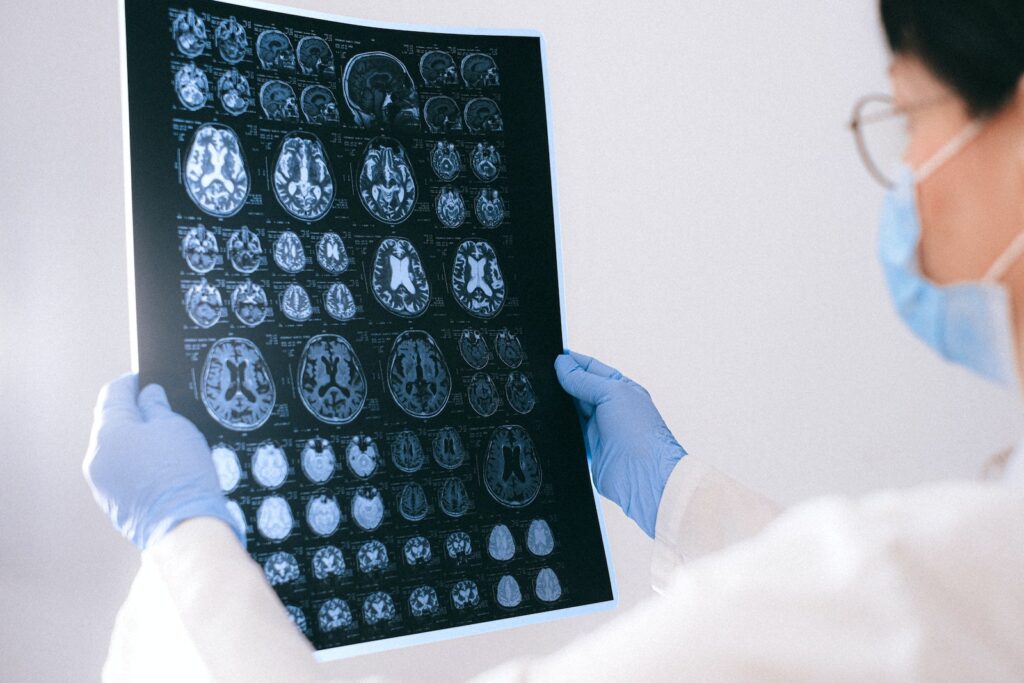Table of Contents
Understanding Parkinson’s Disease and its Symptoms
Parkinson’s disease is a progressive neurological disorder that affects movement. It occurs when the nerve cells in the brain that produce dopamine, a chemical messenger responsible for transmitting signals between neurons, start to degenerate and die.
The exact cause of Parkinson’s disease is unknown, although researchers believe it may be caused by both genetic and environmental factors. There are also several risk factors associated with developing Parkinson’s disease, including age, gender (men are more likely to develop the condition), and exposure to certain toxins.
The hallmark symptoms of Parkinson’s include:
- Tremors or shaking in one or both hands
- Slowness of movement (bradykinesia)
- Rigidity or stiffness in the limbs or trunk
- Impaired balance and coordination
- Difficulty walking or standing upright without assistance >
Parkinson’s disease can also cause non-motor symptoms such as cognitive impairment, depression, anxiety, sleep problems and fatigue among others. These symptoms can have a significant impact on an individual’s quality of life if left unmanaged.
Non-Invasive Brain Stimulation: What is it?
Parkinson’s Disease is a neurodegenerative disorder that affects millions of people around the world, and currently, there is no known cure. However, advancements in medical technology have led to new treatments that can help alleviate some of the disease’s symptoms. Non-invasive brain stimulation is one such treatment method.
As the name suggests, non-invasive brain stimulation involves using various techniques to stimulate specific areas of the brain from outside the skull without any surgical procedure. The goal here is to alter or modulate neural activity within these targeted regions through electrical or magnetic current.
The two most commonly used types of non-invasive brain stimulation are transcranial magnetic stimulation (TMS) and transcranial electric stimulation (TES). In TMS therapy, a coil placed on top of your scalp delivers an electromagnetic pulse that creates an electrical field within your skull capable of activating neurons in targeted areas. On the other hand, TES therapy uses low-intensity electric currents applied via electrodes attached to the patient’s head to achieve similar results.
A few recent studies have found that both TMS and TES therapies could improve symptoms for some Parkinson’s patients by improving motor function and cognitive abilities by increasing dopamine levels in critical areas of their brains.
In conclusion,
non-invasive brain simulation has great potential as a cost-effective alternative solution for treating Parkinson’s disease’s symptoms without surgery-induced complications.
How Non-Invasive Brain Stimulation can Benefit Parkinson’s Patients
Parkinson’s disease is a common neurodegenerative disorder that affects the nervous system and causes tremors, rigidity, and other motor symptoms. While there are various medications and therapies available to help manage these symptoms, non-invasive brain stimulation has emerged as a promising new treatment option for Parkinson’s patients.
Non-invasive brain stimulation techniques use electrical or magnetic energy to target specific areas of the brain associated with movement control. These techniques can be applied without surgery or invasive procedures, making them safe and minimally disruptive options for Parkinson’s patients.
In particular, two types of non-invasive brain stimulation have shown promise in helping alleviate Parkinson’s symptoms: transcranial magnetic stimulation (TMS) and transcranial direct current stimulation (tDCS).
TMS
TMS involves using electromagnetic coils placed on the scalp to deliver short bursts of magnetic energy to targeted regions of the brain. This technique has been used successfully in studies to improve bradykinesia (slowness of movement), tremors, stiffness, balance issues related to walking ability and gait abnormalities experienced by some PD patients.
tDCS
tDCS uses electrodes placed on the scalp that emit low-level electric currents aimed at modifying activity levels within neurons responsible for controlling movements. Multiple sessions per week are required which can last 20 minutes each session over several weeks long period. Studies show tDCS may provide modest relief from cognitive impairment experienced by people suffering from Parkinson’s disease such problems with memory recall.
Both TMS & tDCS treatments rely on identifying accurate locations in cortical areas implicated by functional MRI scans along with knowledgeable neuroradiologists experts who know how capture precisely where exactly sites located across subject’s brains require stimulus via understanding their unique anatomical variability when matching standardized templates to TMS and tDCS stimulation coordinates. Therefore, neuroimaging approaches can substantially increase the accuracy of these non-invasive brain stimulation techniques which are still in their infancy.
While research into non-invasive brain stimulation treatments for Parkinson’s disease is still ongoing, the results so far have been promising. These therapies provide an exciting new option for patients looking to manage their symptoms without invasive surgeries or medication with unwanted side effects.
Different Techniques for Non-Invasive Brain Stimulation
The most common technique is called transcranial magnetic stimulation (TMS). This involves placing a coil near the scalp that generates magnetic pulses to stimulate specific parts of the brain. TMS has shown promising results in reducing symptoms of Parkinson’s disease such as tremors, stiffness and mobility impairment.
Another technique is called transcranial direct current stimulation (tDCS), which uses a weak electrical current to stimulate the brain. tDCS can be used to increase or decrease activity in targeted regions of the brain and has been shown to improve motor function in individuals with Parkinson’s disease.
A newer technique is called repetitive transcranial magnetic stimulation (rTMS), which delivers multiple TMS pulses over time at regular intervals. rTMS has shown potential for improving gait and balance, cognitive performance, and overall quality of life for people with Parkinson’s disease.
In addition to these techniques, there are other forms of non-invasive brain stimulation being explored for their potential benefits on Parkinson’s disease symptoms. These include transcutaneous vagus nerve stimulation (tVNS) – stimulating specific regions within the ear using electric impulses – neuromodulation therapy- electrical pulse therapy externally or surgically implanted stimulators– among others..
Potential Risks and Side Effects of Non-Invasive Brain Stimulation for Parkinson’s Disease
Non-Invasive Brain Stimulation (NIBS) is an emerging technology for Parkinson’s Disease that has shown promise in reducing symptoms and improving quality of life in patients. However, like all medical treatments, it comes with potential risks and side effects.
The most common risk associated with NIBS is headaches. Patients may experience mild to severe headaches during or after treatment. This can be caused by the electrical stimulation or changes in blood flow to the brain. In some cases, these headaches may last for several hours or days after treatment.
In rare cases, NIBS can cause seizures. Seizures occur when there is abnormal electrical activity in the brain, which can be triggered by NIBS. Although seizures are rare, they can be extremely dangerous and require immediate medical attention.
Nausea and dizziness are also potential side effects of NIBS. These symptoms usually occur during treatment and typically resolve within a few minutes after it ends.
Skin irritation where electrodes were placed on the scalp is another possible side effect of NIBS. This generally resolves within a few hours but could take up to a day to recover fully.i
Most importantly – as with any new medical procedure – not enough research exists yet regarding its long term effects over time; therefore, long-term safety cannot be guaranteed by neuroscientists until we have studied this approach more extensively over months if not years before using it as standard practice for PD care permanently.
Overall though while there are some risks involved with Non-Invasive Brain Stimulation that must first undergo further clinical testing studies among larger sample populations – when done correctly under supervision from experts who know what they’re doing? It seems promising so far compared other traditional pharmaceutical treatments for Parkinson’s Disease
If you are considering NIBS treatment, it is important to discuss your concerns with a qualified medical professional. They can help weigh the risks and benefits of this treatment option based on your individual Parkinson’s diagnosis.
Conclusion: Future Implications of Non-Invasive Brain Stimulation
Non-invasive brain stimulation (NIBS) has shown promise in the treatment of Parkinson’s disease. As NIBS continues to gain attention as a potential therapy for various neurological disorders, researchers are making strides in understanding how it can be used most effectively.
In the future, we may see a greater emphasis on personalized medicine when it comes to NIBS treatment for Parkinson’s patients. Scientists are exploring ways to tailor the technique based on each patient’s unique needs and characteristics.
Another exciting development is the use of closed-loop systems that can detect and respond in real-time to changes in brain activity, allowing for more precise targeting of specific neural pathways associated with Parkinson’s symptoms. These types of systems could lead to even better outcomes for patients undergoing NIBS therapy.
The increasing availability of wearable technology also holds promise for improving NIBS treatments. Wearables like smartwatches or headsets could allow doctors and researchers to monitor patients during and after treatment sessions, providing valuable insights into how their brains react over time.
In conclusion, while there is still much research needed before we fully understand the effectiveness and long-term implications of non-invasive brain stimulation for Parkinson’s disease, current findings show great promise. With continued exploration into personalized treatments, closed-loop systems and wearables monitoring technologies – the future looks bright for this emerging field of study




